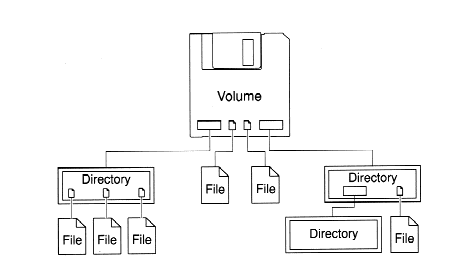
In order to use AmigaDOS to access information, you must know where that information is located. On an Amiga, all information is stored in a system of directories and files. This is the same system used by the Workbench, only the method of working with it is different. Most notably, you do not use icons to manipulate the files and directories. See the Workbench User's Guide for detailed information aboutthe Amiga file system and the use of common commands. Use this section to review the following AmigaDOS basic concepts:

The following are the main elements of the AmigaDOS file system:

AmigaDOS stores information on a device in a file system, which is an organization of directories, subdirectories, and files. Directories and files are arranged in a hierarchical system often referred to as a tree. The branches are directories, which can include subdirectories. At th ends of the branches are the files, unless the directory is empty. Figure 3-1 illustrates a directory tree.

Figure 3-1. Example Directory Tree

Devices include logical devices and the hardware associated with your Amiga, such as floppy disk drives, hard disk drives, the Ram Disk, RAD:, and peripheral devices. Information stroed on these devices can be accessed using a variety of names.
To access files on a particular volume, you can refer to the volume by its volume name, such as Workbench:, or its device name, such as DF0:. Use the names interchangeably; however, you must always include the colon (:) after the name. When you refer to a disk by volume name, the system searches all the available drives for the volume. If it cannot find a volume of that name, a requester asks you to insert the volume. When you refer to the disk by a particular device name, the system uses whatever volume is inserted in that device.
AmigaDOS has standard names assigned to peripheral devices that are attached to the various ports, as well as to various logical (software) devices. Generally, these devices are used for output, such as copying a file to a printer. The standard device names are:

Directories are the AmigaDOS equivalent to drawers in Workbench. They allow you to group and classify related files. Each file on a disk is located in a directory. An empty, formatted disk contains one directory, the root directory. If you create a file on an empty disk, that file resides in the root directory. If the file has an icon attached to it, the icon appears in the disk window.
Directories can contain other directories, called subdirectories. The Amiga supports an arbitrary number of nested directories (directories within directories).
